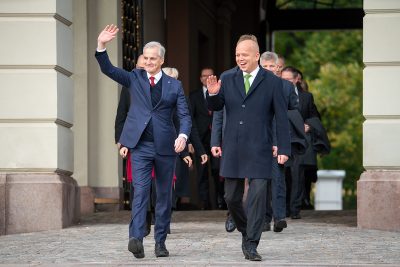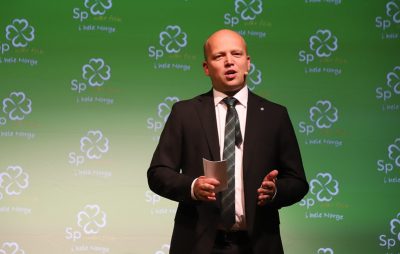The first public opinion poll of the New Year shows how tens of thousands of Norwegian voters are unhappy with their government. Both the Labour and Center parties have already lost many of the voters who allowed them to form a minority government coalition last fall, and it’s now weakened considerably since the September election.

Labour lost the largest chunk of voters, falling 3.9 points in the poll conducted by research firm Norstat for newspaper Aftenposten and Norwegian Broadcasting (NRK). Labour now holds only 21.1 percent of the vote, compared to the last poll in December.
Center, meanwhile, now has support from just 9.8 percent of Norwegian voters, after tumbling 2.6 points and landing below the 10 percent mark for the first time since September 2017. Both Labour and Center have lost considerable ground since the September election, when Labour emerged as Norway’s largest party with 26.3 percent of the vote and Center won 13.5 percent. They’re now running the country with just under 31 percent of the voters behind them.
The poll results have surprised political experts and election researchers, since the government parties’ losses are larger than the margins of error routinely attached to all polling (1.2 to 3.3 points in the new Aftenposten-NRK poll). That means there’s no doubt that both parties have lost voters who helped put them in office: Around 250,000 Norwegian voters are believed to have lost faith in both Labour and Center after just over three months in office.
“This is a surprisingly large setback for Labour and Center,” Johannes Bergh, a leader at Norway’s Institute for Social Research (Institutt for sammfunnsforskring), told NRK. He was on national radio Wednesday morning, and said that most government parties “experience some form of slitasje (wear and tear) … but for Labour and Center, this has come very quickly.”
The voter dissatisfaction is widely linked to public frustration over the government’s suddenly harsh response last month to the ongoing pandemic in Norway, and to record-high electricity bills that just keep rising. The new Labour-Center government imposed few Corona-related restrictions during their first two months in office, even as infection levels rose, only to suddenly crack down on all social gatherings at the height of the holiday party season. Norwegians now also face monthly electricity bills that are at least doubling for their homes and businesses and even tripling at holiday homes, even after the government finally announced some compensation measures just before Christmas.
In addition comes a general decline in Norwegians’ traditionally high levels of confidence in their elected leaders. It took the media to reveal years worth of top politicians’ exploitation of generous housing, travel expense and severance pay benefits that come in addition to relatively high salaries. Most all parties were involved, but the most spectacular case involved Labour’s own newly elected president of the Norwegian Parliament, Eva Kristin Hansen, who felt compelled to resign after less than a month in the position that ranks second only to the monarch. Center MPs have also been among those receiving excessive compensation from Parliament.

The Center Party and its leader Trygve Slagsvold Vedum (now also Norway’s finance minister) have also come under fire from voters who feel let down.
The anti-EU Vedum has been caught, for example, in wrongly blaming EU-linked rules for the government’s failure to offer more compensation for employees facing layoff. He also faces lots of obstacles and huge expense to taxpayers in following through on campaign promises to reverse both municipal and county mergers, reopening closed police stations and health care services in rural areas and lowering various taxes and fees.
Even Vedum’s campaign to cut bureaucracy and staffing has left him embarrassed: “We don’t need seven state secretaries in the prime minister’s office,” he told reporters in June. Now there are eight. Taxes and fees on a wide variety of services also rose from January 1st, by a collective NOK 8.6 billion, reported Aftenposten last week.
Vedum, notes political commentator Kjetil B Alstadheim in Aftenposten, “has been successful as a politician in opposition, by shooting from the hip with simple analyses and even simpler solutions. Now he’s finance minister, and that demands both precision and impulse control.” He can “no longer blame ‘the EU’ or ‘Brussels’ or Norway’s trade agreement with the EU for everything that’s painful and difficult,” Alstadheim wrote last month.
Reds Party is the biggest winner
Vedum was also adamantly opposed to forming a left-center government that could have included the Socialist Left Party (SV), even though SV would have given such a coalition a majority in Parliament. Now both Labour and Center need SV more than ever, not least since SV has won credit for forcing needed changes in government policy on several issues this fall and making them more acceptable to voters. Now SV is also nearly as big as Center, with 9.1 percent of the vote in the latest poll, up from the 7.5 percent won in the last election, although its support also fell from the December poll by 1.1 points.
The biggest winner in the new poll is the Reds Party (Rødt), which gained 1.2 points to claim 6.2 percent of the vote. It’s become a much more powerful player in Norwegian politics over the past few years. After winning 4.7 percent of the vote in the September election, it qualified for full representation in Parliament and could thus claim eight seats. The new poll results would give it 11.

Overall voter support remains, however, more fragmented than ever. Neither the left nor the right side has a solid voter majority at present, even though the left side would still hold more seats in Parliament. The Conservatives are once again largest, climbing 2.6 points to claim 24.7 percent of the vote. All three of its of its former government partners (the Progress, Liberal and Christian Democrats parties) also won back voters in the new Aftenposten-NRK poll.
But it all leaves Norway’s four non-socialist parties holding 46.7 percent of the vote and the five non-socialist parties holding 49.6 percent. Left with a potential swing vote is the lone member from Northern Norway who represents a movement to support a hospital in Alta.
Conservatives’ leader and former prime minister Erna Solberg was predictably satisfied with the political sentiment of the new poll. “I think perhaps voters miss another government and its policies,” Solberg told NRK, with a clear reference to her own coalition that ruled for two terms. The new government isn’t only battered by crises, she claims.
“It’s how you handle situations of that type that always matters,” Solberg said. “When we see voters opting for other parties, it shows that many other issues are at stake.” She also emerged in the new poll, meanwhile, as the preferred prime minister, if only barely: When voters were asked who they thought was best suited to be prime minister, 38.5 percent answered “Solberg,” while 37.4 percent answered “Støre.” Fully 24.2 percent were undecided.
newsinenglish.no/Nina Berglund

